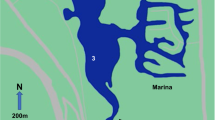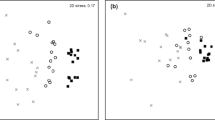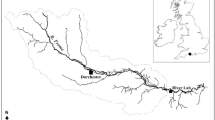Abstract
Crabs are ecosystem engineers that dig burrows, which can trap sediment. We used a field experiment to explore how burrow aspect ratio (depth/diameter) affects the trapping efficiency of sediments and organic material. Arrays of burrows mimics were constructed using tubes of similar depths but two different opening diameters: fat tubes (aspect ratio of 3.8) and thin tubes (7.1). Different arrays were tested to examine whether the combination of burrows with two different aspect ratios affects the material capture, while retaining the same total area of openings per array. The results showed that, in general, the fat tubes trapped more organic material, especially large pieces, and more sediment than thin tubes. Furthermore, the silt-clay content of the sediment trapped in the tubes was up to 50% greater than the surrounding surficial sediment. Hence, we conducted 2D numerical simulations of flow around, and into, a single burrow to elucidate the mechanisms behind particle capture. Results showed that the flushing rate and the turbulent kinetic energy were greater in the fat tubes. However, turbulence persisted for a longer distance downstream of the thin tubes than the fat tubes. The enhanced turbulence may increase the flux of sediment into the tubes where particles can settle and, consequently, promote the sediment capture and sedimentation rate. Our results demonstrate that the aspect ratio of burrows significantly affects capture processes of organic material and sediment particles. Moreover, this capture mechanism depends on the flow regime, as faster flows are associated with larger amounts of material in the water column.








Similar content being viewed by others
References
Babu V, Korpela SA (1994) Numerical solution of the incompressible three-dimensional Navier-Stokes equations. Comput Fluids 23:675–691. https://doi.org/10.1016/0045-7930(94)90009-4
Botella O, Peyret R (1998) Benchmark spectral results on the lid-driven cavity flow. Comput Fluids 27:421–433. https://doi.org/10.1016/S0045-7930(98)00002-4
Botto F, Iribarne O (2000) Contrasting effects of two burrowing crabs (Chasmagnathus granulata and Uca uruguayensis) on sediment composition and transport in estuarine environments. Estuar Coast Shelf Sci 51:141–151. https://doi.org/10.1006/ecss.2000.0642
Botto F, Iribarne O, Gutierrez J, Bava J, Gagliardini A, Valiela I (2006) Ecological importance of passive deposition of organic matter into burrows of the SW Atlantic crab Chasmagnathus granulatus. Mar Ecol Prog Ser 312:201–210. https://doi.org/10.3354/meps312201
Bouma T, Van Duren L, Temmerman S, Claverie T, Blanco-Garcia A, Ysebaert T, Herman P (2007) Spatial flow and sedimentation patterns within patches of epibenthic structures: Combining field, flume and modelling experiments. Cont Shelf Res 27:1020–1045. https://doi.org/10.1016/j.csr.2005.12.019
Butman CA (1986) Sediment trap biases in turbulent flows: results from a laboratory flume study. J Mar Res 44:645–693. https://doi.org/10.1357/002224086788403051
Butman CA, Grant WD, Stolzenbach KD (1986) Predictions of sediment trap biases in turbulent flows: a theoretical analysis based on observations from the literature. J Mar Res 44:601–644. https://doi.org/10.1357/002224086788403024
Coco G, Thrush SF, Green MO, Hewitt JE (2006) Feedbacks between bivalve density, flow, and suspended sediment concentration on patch stable states. Ecology 87:2862–2870. https://doi.org/10.1890/0012-9658(2006)87[2862:FBBDFA]2.0.CO;2
Cortes A, Miller J (1994) Numerical experiments with the lid driven cavity flow problem. Comput Fluids 23:1005–1027. https://doi.org/10.1016/0045-7930(94)90002-7
Eckman JE (1983) Hydrodynamic processes affecting benthic recruitment. Limnol Oceanogr 28:241–257. https://doi.org/10.4319/lo.1983.28.2.0241
Eckman JE, Nowell AR, Jumars PA (1981) Sediment destabilization by animal tubes. J Mar Res 39:361–373
Escapa M, Perillo GM, Iribarne O (2008) Sediment dynamics modulated by burrowing crab activities in contrasting SW Atlantic intertidal habitats. Estuar Coast Shelf Sci 80:365–373. https://doi.org/10.1016/j.ecss.2008.08.020
Friedrichs M, Graf G, Springer B (2000) Skimming flow induced over a simulated polychaete tube lawn at low population densities. Mar Ecol Prog Ser 192:219–228. https://doi.org/10.3354/meps192219
Friedrichs M, Leipe T, Peine F, Graf G (2009) Impact of macrozoobenthic structures on near-bed sediment deposition rates. J Mar Syst 75:336–347. https://doi.org/10.1016/j.jmarsys.2006.12.006
Gardner WD (1980a) Field assessment of sediment traps. J Mar Res 38:41–52
Gardner WD (1980b) Sediment trap dynamics and calibration: a laboratory evaluation. J Mar Res 38:17–39
Gardner WD (1985) The effect of tilt on sediment trap efficiency. Deep Sea Research Part A. Oceanogr Res Pap 32:349–361. https://doi.org/10.1016/0198-0149(85)90083-4
Ghia U, Ghia KN, Shin C (1982) High-Re solutions for incompressible flow using the Navier-Stokes equations and a multigrid method. J Comput Phys 48:387–411. https://doi.org/10.1016/0021-9991(82)90058-4
Gibbs M, Thrush S, Ellis J (2001) Terrigenous clay deposition on estuarine sandflats: using stable isotopes to determine the role of the mud crab, Helice crassa Dana, in the recovery process. Isot Environ Health Stud 37:113–131. https://doi.org/10.1080/10256010108033288
Gilbert F, Aller RC, Hulth S (2003) The influence of macrofaunal burrow spacing and diffusive scaling on sedimentary nitrification and denitrification: an experimental simulation and model approach. J Mar Res 61:101–125. https://doi.org/10.1357/002224003321586426
Grace JR (1986) Contacting modes and behaviour classification of gas-solid and other two-phase suspensions. Can J Chem Eng 64:353-363.https://doi.org/10.1002/cjce.5450640301
Graf G, Rosenberg R (1997) Bioresuspension and biodeposition: a review. J Mar Syst 11:269–278. https://doi.org/10.1016/S0924-7963(96)00126-1
Green JC (2005) Comparison of blockage factors in modelling the resistance of channels containing submerged macrophytes. River Res Appl 21:671-686. https://doi.org/10.1002/rra.854
Heron S, Ridd P (2001) The use of computational fluid dynamics in predicting the tidal flushing of animal burrows. Estuar Coast Shelf Sci 52:411–421. https://doi.org/10.1006/ecss.2000.0761
Heron S, Ridd P (2003) The effect of water density variations on the tidal flushing of animal burrows. Estuar Coast Shelf Sci 58:137–145. https://doi.org/10.1016/S0272-7714(03)00068-4
Heron S, Ridd P (2008) The tidal flushing of multiple-loop animal burrows. Estuar Coast Shelf Sci 78:135–144. https://doi.org/10.1016/j.ecss.2007.11.018
Iribarne O, Bortolus A, Botto F (1997) Between-habitat differences in burrow characteristics and trophic modes in the southwestern Atlantic burrowing crab Chasmagnathus granulata. Mar Ecol Prog Ser 155:137–145. https://doi.org/10.3354/meps155137
Iribarne O, Botto F, Martinetto P, Gutierrez JL (2000) The role of burrows of the SW Atlantic intertidal crab Chasmagnathus granulata in trapping debris. Mar Pollut Bull 40:1057–1062. https://doi.org/10.1016/S0025-326X(00)00058-8
Kristensen E & Kostka J (2005) Macrofaunal burrows and irrigation in marine sediment: microbiological and biogeochemical interactions. Interactions between Macro-and Microorganisms in Marine Sediments, pp 125–157. https://doi.org/10.1029/CE060p0125
Ku HC, Hirsh RS, Taylor TD (1987) A pseudospectral method for solution of the three-dimensional incompressible Navier-Stokes equations. J Comput Phys 70:439–462. https://doi.org/10.1016/0021-9991(87)90190-2
Laverock B, Gilbert JA, Tait K, Osborn AM, Widdicombe S (2011) Bioturbation: impact on the marine nitrogen cycle. Portland Press Limited. https://doi.org/10.1042/BST0390315
Le Hir P, Monbet Y, Orvain F (2007) Sediment erodability in sediment transport modelling: can we account for biota effects? Cont Shelf Res 27:1116–1142. https://doi.org/10.1016/j.csr.2005.11.016
Le Minor M, Bartzke G, Zimmer M, Gillis LG, Helfer V, Huhn K (2019) Numerical modelling of hydraulics and sediment dynamics around mangrove seedlings: Implications for mangrove establishment and reforestation. Estuar Coast Shelf Sci 217:81-95. https://doi.org/10.1016/j.ecss.2018.10.019
Meadows PS, Meadows A, Murray JM (2012) Biological modifiers of marine benthic seascapes: their role as ecosystem engineers. Geomorphology 157:31–48. https://doi.org/10.1016/j.geomorph.2011.07.007
Morrisey D, Dewitt T, Roper D, Williamson R (1999) Variation in the depth and morphology of burrows of the mud crab Helice crassa among different types of intertidal sediment in New Zealand. Mar Ecol Prog Ser 182:231–242. https://doi.org/10.3354/meps182231
Mullarney JC, Henderson SM, Norris BK, Bryan KR, Fricke AT, Sandwell DR, Culling DP (2017) A question of scale: how turbulence around aerial roots shapes the seabed morphology in mangrove forests of the Mekong Delta. Oceanography 30:34–47. https://doi.org/10.5670/oceanog.2017.312
Murray JM, Meadows A, Meadows PS (2002) Biogeomorphological implications of microscale interactions between sediment geotechnics and marine benthos: a review. Geomorphology 47:15–30. https://doi.org/10.1016/S0169-555X(02)00138-1
Needham H, Pilditch C, Lohrer A, Thrush S (2010) Habitat dependence in the functional traits of Austrohelice crassa, a key bioturbating species. Mar Ecol Prog Ser 414:179–193. https://doi.org/10.3354/meps08726
Needham HR, Pilditch CA, Lohrer AM, Thrush SF (2011) Context-specific bioturbation mediates changes to ecosystem functioning. Ecosystems 14:1096–1109. https://doi.org/10.1007/s10021-011-9468-0
Needham HR, Pilditch CA, Lohrer AM, Thrush SF (2013) Density and habitat dependent effects of crab burrows on sediment erodibility. J Sea Res 76:94–104. https://doi.org/10.1016/j.seares.2012.12.004
Nepf HM (2012) Flow and Transport in Regions with Aquatic Vegetation. Annu Rev Fluid Mech 44:123-142. https://doi.org/10.1146/annurev-fluid-120710-101048
Nickell L, Atkinson R, Hughes D, Ansell A, Smith C (1995) Burrow morphology of the echiuran worm Maxmuelleria lankesteri (Echiura: Bonelliidae), and a brief review of burrow structure and related ecology of the Echiura. J Nat Hist 29:871–885. https://doi.org/10.1080/00222939500770311
Norris BK, Mullarney JC, Bryan KR, Henderson SM (2017) The effect of pneumatophore density on turbulence: a field study in a Sonneratia-dominated mangrove forest, Vietnam. Cont Shelf Res 147:114–127. https://doi.org/10.1016/j.csr.2017.06.002
Norris BK, Mullarney JC, Bryan KR, Henderson SM (2019) Turbulence within natural mangrove pneumatophore canopies. J Geophys Res Oceans 124:2263–2288. https://doi.org/10.1029/2018JC014562
Nowell AR, Church M (1979) Turbulent flow in a depth-limited boundary layer. J Geophys Res Oceans 84:4816–4824. https://doi.org/10.1029/JC084iC08p04816
Nowell A, Jumars P (1984) Flow environments of aquatic benthos. Annu Rev Ecol Syst 15:303–328. https://doi.org/10.1146/annurev.es.15.110184.001511
Oberkampf WL, Trucano TG (2008) Verification and validation benchmarks. Nucl Eng Des 238:716–743. https://doi.org/10.1016/j.nucengdes.2007.02.032
O'Brien V (1972) Closed streamlines associated with channel flow over a cavity. Phys Fluids 15:2089–2097. https://doi.org/10.1063/1.1693840
Ozalp C, Pinarbasi A, Sahin B (2010) Experimental measurement of flow past cavities of different shapes. Exp Thermal Fluid Sci 34:505–515. https://doi.org/10.1016/j.expthermflusci.2009.11.003
Palau-Salvador G, Stoesser T, Fröhlich J, Kappler M, Rodi W (2010) Large eddy simulations and experiments of flow around finite-height cylinders. Flow Turbul Combust 84:239. https://doi.org/10.1007/s10494-009-9232-0
Spalding DB (1961) A Single Formula for the “Law of the Wall”. J Appl Mech 28:455-458. https://doi.org/10.1115/1.3641728
Takemoto Y, Abe Y, Naitou H & Yamabe H (1984) On the third-order upwind finite-difference scheme in numerical analysis for initial-value problems. Nagoya Univ.(Japan). Inst. of Plasma Physics
Thrush SF, Hewitt JE, Norkko A, Cummings VJ, Funnell GA (2003) Macrobenthic recovery processes following catastrophic sedimentation on estuarine sandflats. Ecol Appl 13:1433–1455. https://doi.org/10.1890/02-5198
Van Katwijk M, Bos A, Hermus D, Suykerbuyk W (2010) Sediment modification by seagrass beds: muddification and sandification induced by plant cover and environmental conditions. Estuar Coast Shelf Sci 89:175–181. https://doi.org/10.1016/j.ecss.2010.06.008
Vopel K, Hancock N (2005) More than just a crab hole. Water Atmos 13:18–19
Warren JH, Underwood A (1986) Effects of burrowing crabs on the topography of mangrove swamps in New South Wales. J Exp Mar Biol Ecol 102:223–235. https://doi.org/10.1016/0022-0981(86)90178-4
Weiss RF, Florsheim BH (1965) Flow in a cavity at low Reynolds number. Phys Fluids 8:1631–1635. https://doi.org/10.1063/1.1761474
Widdows J, Brinsley M (2002) Impact of biotic and abiotic processes on sediment dynamics and the consequences to the structure and functioning of the intertidal zone. J Sea Res 48:143–156. https://doi.org/10.1016/S1385-1101(02)00148-X
Wiles PJ, Rippeth TP, Simpson JH, Hendricks PJ (2006) A novel technique for measuring the rate of turbulent dissipation in the marine environment. Geophys Res Lett 33. https://doi.org/10.1029/2006GL027050
Witbaard R, Duineveld G (1989) Some aspects of the biology and ecology of the burrowing shrimp Callianassa subterranea (Montagu) (Thalassinidea) from the southern North Sea. Sarsia 74:209–219. https://doi.org/10.1080/00364827.1989.10413430
Yager PL, Nowell AR, Jumars PA (1993) Enhanced deposition to pits: a local food source for benthos. J Mar Res 51:209–236. https://doi.org/10.1357/0022240933223819
Ziebis W, Forster S, Huettel M, Jorgensen B (1996) Complex burrows of the mud shrimp Callianassa truncata and their geochemical impact in the sea bed. Nature 382:619. https://doi.org/10.1038/382619a0
Acknowledgements
The authors are grateful to D. Bell, E. Horstman, N. Lovett and D. Sandwell for the help in the field and laboratory. The authors are grateful to the reviewers for their valuable comments to improve the quality of the manuscript.
Funding
This research was funded by the Deutsche Forschungsgemeinschaft (DFG) through the International Research Training Group INTERCOAST “Integrated Coastal Zone and Shelf-Sea Research” (project no. GRK 1598).
Author information
Authors and Affiliations
Corresponding author
Additional information
Publisher’s note
Springer Nature remains neutral with regard to jurisdictional claims in published maps and institutional affiliations.
Model setup and validation
Model setup and validation
In order to verify and validate the numerical model, several benchmark tests were conducted. According to Oberkampf and Trucano (2008), the simulation of a same case should be run for three different grid sizes as well as three different time steps. In addition, numerical data should be compared with experimental data (numerical, flume or field) to ensure that the model output corresponds to the reality and that its accuracy is in an acceptable or reasonable range. A large number of studies have already been published regarding the flow in cavities: 2D or 3D lid-driven cavity flow in square/cubic or rectangular cavities (Ghia et al. 1982; Ku et al. 1987), flow past open cavities with different shapes (Ozalp et al. 2010). In order to validate our simple model, a square unit cavity and a rectangular cavity were generated. The geometry, as well as the boundary conditions, is shown (Fig. 9a). In total, a set of nineteen numerical experiments was conducted. Nine Reynolds numbers were considered, ranging from 100 to 100,000. A vertical profile of mean streamwise velocity was extracted at X/D = 0.5 and an horizontal profile of mean vertical velocity was extracted at Z/H = 0.5, where X and Z refer to the horizontal and vertical axes, respectively, and, D and H are the length and the height of the cavity, respectively. These profiles were plotted against data from Ghia et al. (1982), Takemoto et al. (1984), Babu and Korpela (1994), Cortes and Miller (1994) and Botella and Peyret (1998). The results of our model validation exhibited good agreement with these numerical data for mean flow speeds and vortex structure (Fig. 9b, c).
Geometry and flow validation of hydrodynamics in square cavity at Re = 1000. a Boundary conditions and geometry of the square cavity (height H equal to diameter D). b Modelled results of mean streamwise velocity plotted against published data. Data were extracted along a vertical profile located at X/D = 0.5. c Modelled results of mean vertical velocity plotted against published data. Data were extracted along a horizontal profile located at Z/H = 0.5
Rights and permissions
About this article
Cite this article
Le Minor, M., Mullarney, J.C., Pilditch, C.A. et al. Crab burrow aspect ratio influences particle capture rates on intertidal sandflats. Geo-Mar Lett 40, 197–216 (2020). https://doi.org/10.1007/s00367-019-00630-x
Received:
Accepted:
Published:
Issue Date:
DOI: https://doi.org/10.1007/s00367-019-00630-x





